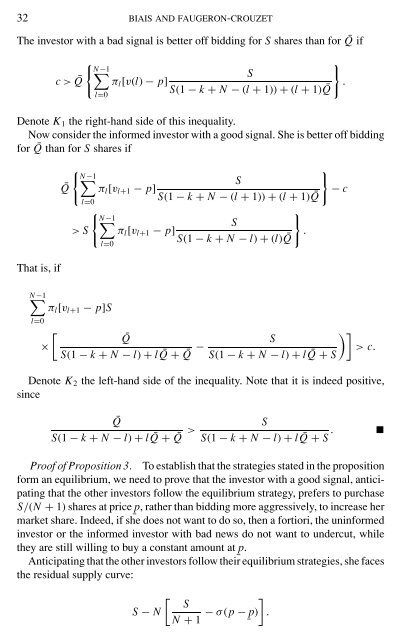IPO Auctions: English, Dutch, ... French, and Internet
IPO Auctions: English, Dutch, ... French, and Internet
IPO Auctions: English, Dutch, ... French, and Internet
Create successful ePaper yourself
Turn your PDF publications into a flip-book with our unique Google optimized e-Paper software.
32 BIAIS AND FAUGERON-CROUZET<br />
The investor with a bad signal is better off bidding for S shares than for ¯Q if<br />
c > ¯Q<br />
N−1<br />
<br />
<br />
S<br />
πl[v(l) − p]<br />
.<br />
S(1 − k + N − (l + 1)) + (l + 1) ¯Q<br />
l=0<br />
Denote K1 the right-h<strong>and</strong> side of this inequality.<br />
Now consider the informed investor with a good signal. She is better off bidding<br />
for ¯Q than for S shares if<br />
That is, if<br />
N−1<br />
<br />
<br />
¯Q<br />
S<br />
πl[vl+1 − p]<br />
− c<br />
S(1 − k + N − (l + 1)) + (l + 1) ¯Q<br />
l=0<br />
<br />
N−1<br />
S<br />
> S πl[vl+1 − p]<br />
.<br />
S(1 − k + N − l) + (l) ¯Q<br />
l=0<br />
N−1<br />
πl[vl+1 − p]S<br />
l=0<br />
<br />
¯Q<br />
×<br />
S(1 − k + N − l) + l ¯Q + ¯Q −<br />
<br />
S<br />
> c.<br />
S(1 − k + N − l) + l ¯Q + S<br />
Denote K2 the left-h<strong>and</strong> side of the inequality. Note that it is indeed positive,<br />
since<br />
¯Q<br />
S(1 − k + N − l) + l ¯Q + ¯Q ><br />
S<br />
S(1 − k + N − l) + l ¯Q + S .<br />
Proof of Proposition 3. To establish that the strategies stated in the proposition<br />
form an equilibrium, we need to prove that the investor with a good signal, anticipating<br />
that the other investors follow the equilibrium strategy, prefers to purchase<br />
S/(N + 1) shares at price p ¯ , rather than bidding more aggressively, to increase her<br />
market share. Indeed, if she does not want to do so, then a fortiori, the uninformed<br />
investor or the informed investor with bad news do not want to undercut, while<br />
they are still willing to buy a constant amount at p ¯ .<br />
Anticipating that the other investors follow their equilibrium strategies, she faces<br />
the residual supply curve:<br />
<br />
S<br />
S − N<br />
N + 1 − σ (p − p ¯ )<br />
<br />
.
















